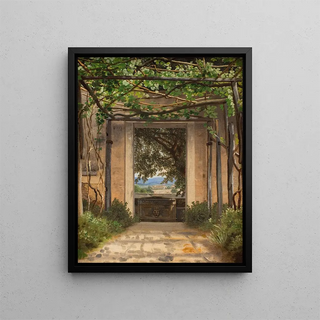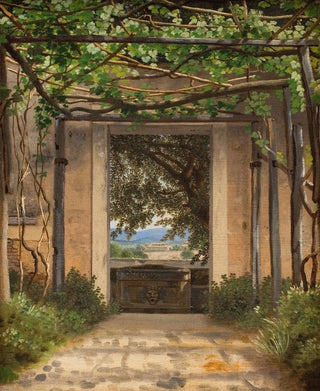Art print | A pergola in Italy - Christoffer Wilhelm Eckersberg Source: Reproduction | Une pergola en Italie - Christoffer Wilhelm Eckersberg


View from behind

Frame (optional)
The artwork "A Pergola in Italy" by Christoffer Wilhelm Eckersberg is an invitation to travel to the heart of Italian beauty, captured with a delicacy and precision that define this 19th-century Danish artist. By contemplating this scene, the viewer is transported into a universe where light plays with shadows, revealing the richness of colors and the depth of emotions. Eckersberg, known for his keen eye on nature and architecture, manages to create an almost tangible atmosphere, where every detail seems to tell a story. This piece, both intimate and universal, depicts a frozen moment in time—a contemplative pause within an enchanting landscape.
Style and uniqueness of the artwork
Eckersberg's style is distinguished by his ability to blend realism and emerging impressionism. In "A Pergola in Italy," the composition is carefully orchestrated, with each element thoughtfully placed to create a harmonious balance. The play of light, typical of his approach, illuminates the pergola and the surrounding vegetation, giving the whole a warm and welcoming atmosphere. The shades of green and earth tones, mixed with touches of bright color, evoke the lushness of Italian nature. This painting is not only a tribute to the beauty of the landscape but also an exploration of human emotions in the face of nature's magnificence. The artwork exudes a serenity that invites contemplation and reflection on our own relationship with the environment around us.
The artist and his influence
Christoffer Wilhelm Eckersberg is often regarded as the father of modern Danish painting. His training at the Royal Danish Academy of Fine Arts in Copenhagen, as well as his stays in Paris, shaped his unique style, combining academic rigor with personal sensitivity. Influenced by masters such as David and Delacroix, Eckersberg developed an approach that is distinctly his own, marked by meticulous attention to detail and a deep understanding of light play. His work has had a significant impact on subsequent generations of Scandinavian artists, who drew from his legacy to explore new creative paths. Through his

Matte finish

View from behind

Frame (optional)
The artwork "A Pergola in Italy" by Christoffer Wilhelm Eckersberg is an invitation to travel to the heart of Italian beauty, captured with a delicacy and precision that define this 19th-century Danish artist. By contemplating this scene, the viewer is transported into a universe where light plays with shadows, revealing the richness of colors and the depth of emotions. Eckersberg, known for his keen eye on nature and architecture, manages to create an almost tangible atmosphere, where every detail seems to tell a story. This piece, both intimate and universal, depicts a frozen moment in time—a contemplative pause within an enchanting landscape.
Style and uniqueness of the artwork
Eckersberg's style is distinguished by his ability to blend realism and emerging impressionism. In "A Pergola in Italy," the composition is carefully orchestrated, with each element thoughtfully placed to create a harmonious balance. The play of light, typical of his approach, illuminates the pergola and the surrounding vegetation, giving the whole a warm and welcoming atmosphere. The shades of green and earth tones, mixed with touches of bright color, evoke the lushness of Italian nature. This painting is not only a tribute to the beauty of the landscape but also an exploration of human emotions in the face of nature's magnificence. The artwork exudes a serenity that invites contemplation and reflection on our own relationship with the environment around us.
The artist and his influence
Christoffer Wilhelm Eckersberg is often regarded as the father of modern Danish painting. His training at the Royal Danish Academy of Fine Arts in Copenhagen, as well as his stays in Paris, shaped his unique style, combining academic rigor with personal sensitivity. Influenced by masters such as David and Delacroix, Eckersberg developed an approach that is distinctly his own, marked by meticulous attention to detail and a deep understanding of light play. His work has had a significant impact on subsequent generations of Scandinavian artists, who drew from his legacy to explore new creative paths. Through his






